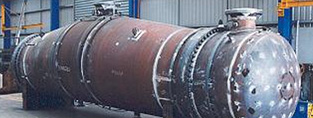
- (03) 5909 8218
- enquiry@fusionweld.com.au
Standards of Pressure Piping System
September 12, 2016

We've covered pressure vessel structural viability with zeal, but now it's time to turn the spotlight, to illuminate the standards of pressure piping systems. Considerations for these essential fluid conduits are governed by many design factors, all of which ensure flow integrity is reinforced. After all, a vessel is a known quantity, one that occupies finite space, but pipework assemblies zoom off in sectional tangles. They require coupling mechanisms, junctures, and any number of extraneous parts, so the piping system must not be perceived as a weak link.
International Standards of Pressure Piping Systems
Mechanical pipework synergy rules this domain, so expect to see the Australian piping code AS4041—2006 align with the American ASME B31.3 2008 standard as well as several other international codes. These regulations provide a guide to the selection of pipework in any imaginable industrial or commercial scenario, so pipe thickness and pipe fixtures are all covered in this publication. On covering this topic from a less legislated viewpoint, the goal is simply to evaluate the processing criteria and provide a fluid transportation framework that safely distributes that particular fluid through a mechanically robust channel.
Factors to Consider When Designing Pressure Piping Systems
The engineering team views the fluid distributing channels as a vast network, one that's uniformly pressurized by a known medium. Influencing factors that could undermine the pipes include:
- The overall thickness of the pipe
- Material fabrication methodologies
- Flow characteristics of the fluid
- Chemical properties of the fluid
- Maximum and minimum working pressure
Above and beyond these conditional factors, the length of the pipe, number of twists and turns, and any extreme environmental factors play a role in the design. Finally, perhaps most importantly, the mechanical couplers that connect each section must be assessed. This latter consideration will likely be implemented as part of a continuous preventative maintenance plan.
Governing the Standards
As the standards of piping systems divide and divide again, the regulations adjust to complement these changes. There are codes that dictate the design of pressurized fuel and gas distribution networks, for instance, but other sections require greater design acuity. We're referring to chemical processing plants, the pipes that endure under caustic chemical changes and near explosive catalyzing reactions.
Pressure vessel design is a complex subject, one that uses geometrical profiles and proven fabrication technology. But pressure piping design is also a complex science, one that uses many factors to build a fluid distribution network that can safely transport pressurized liquids and gasses over long distances.
Contact Details
Fusion - Weld Engineering Pty Ltd
ABN 98 068 987619
1865 Frankston Flinders Road,
Hastings, VIC 3915
Ph: (03) 5909 8218
Optimized by NetwizardSEO.com.au
Recent Posts
- Heat Exchanger Maintenance in Melbourne: Minimising Risk in Power Generation Facilities
- Compressed Hydrogen Storage Vessels: Material Selection, Design & Australian Standards
- Welding QA/QC in Oil & Gas Pressure Vessel Fabrication – Ensuring Code Compliance
- AS1210 vs ASME VIII Pressure Vessel Code: Key Differences for Australian Projects
- Mitigating Hydrogen-Induced Cracking in Pressure Vessels: Engineering and Material Strategies
- Storage Tank Solutions Australia: Field-Erected, Prefabricated & Self-Bunded Explained
- Reducing Environmental Risks: Self-Bunded Tanks in Australian Oil & Gas Operations
- Precision in Production: How Pressure Vessels Are Manufactured for Industrial Safety
- Shell & Tube Heat Exchangers: Improve Thermal Control & Energy Recovery in Petrochemical & Pharmaceutical Plants
- In-Service Inspection for Compressed Air Receivers for Power Plant Shutdown Prevention
- Power Plant Pipe Spooling Fabrication – Get Rapid, Code-Compliant Spools Ready for Installation
- Field Erected Tanks: Safe, Reliable On-Site Fuel Storage Solutions in Australia
Posts 2026
- Heat Exchanger Maintenance in Melbourne: Minimising Risk in Power Generation Facilities
- View all articles…
Posts 2025
- Compressed Hydrogen Storage Vessels: Material Selection, Design & Australian Standards
- Welding QA/QC in Oil & Gas Pressure Vessel Fabrication – Ensuring Code Compliance
- View all articles…
Posts 2024
- Large Process Vessels: Optimising the Design for Maximum Efficiency [2025]
- Pressure Equipment Management System Installation: Detect Equipment Faults Early
- View all articles…
Posts 2023
- Pressure Piping System Inspection: A Gift of Safety for the Holidays
- Deaerator Inspections by Fusion-Weld Engineering and How They Reduce System Downtime
- View all articles…
Posts 2022
- How Fusion Weld Keeps Up With AS-NZS ISO 9001:2008 Standard
- Boiler Equipment Safety Inspection During the Summer Season
- View all articles…
Posts 2021
- Avoid These Factors and Practices that Contribute to Sealing Damage in Pressure Vessels
- Do's And Don'ts Of Industrial Boiler Inspection And Maintenance From Fusion-Weld
- View all articles…
Posts 2020
- What are the Risks and Hazards Involved in Pressure Vessel Equipment?
- How to Know if Your Pressure Equipment Needs Repair or Replacement?
- View all articles…
Posts 2019
- Factors that Contribute to Pressure Vessel Failure
- Pressure Vessel Regulations in Australia: What are the Mandatory Requirements?
- View all articles…
Posts 2018
- Pros and Cons of Spherical vs. Cylindrical Pressure Vessels
- What are the Different Hazard Levels in Pressure Vessels?
- View all articles…
Posts 2017
- Transportable Pressure Vessels: The Importance of Inspection and Safety Checks
- Fracture Mechanics and Stress Analysis of Cracks in Pressure Vessels
- View all articles…
Posts 2016
Posts 2015
- What Are Deaerators & Feedwater Vessels?
- Precautions and Safety for Compressed Air Receiver Vessels
- View all articles…
Posts 2014
- Demonstrating In-process Inspection Procedures
- Static Grounding Practices and Standards
- View all articles…